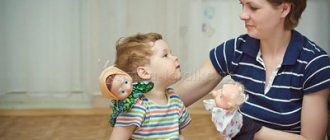In modern speech therapy, the term “ontogenesis of speech development” is understood as the patterns of mastery of all its components, the peculiarities of the formation of the language system in humans. The beginning is the appearance of the first words, but some experts also include the manifestation of speech reactions (humming, babbling). Understanding these features is important for drawing up correctional speech therapy work and identifying dysontogenesis in a child.
There are several classifications proposed by famous speech therapists and linguists. The most popular periodization was compiled by A. N. Gvozdev, who described in detail the child’s acquisition of parts of speech. They also often refer to the patterns identified by A. N. Leontyev. Based on knowledge of normal speech ontogenesis, speech therapists can determine its impairment in children.
Periodization according to A. N. Leontiev
A. N. Leontyev identified 4 main stages of speech development in ontogenesis, which begin at birth and cover the school years. A brief description of them is presented below.
Preparatory stage
In the period from birth to one year, the prerequisites are created for mastering the components of the language system. The first vocal reactions are screaming and crying, which contribute to the development of the respiratory, vocal and articulatory departments.
At the age of several weeks, the baby begins to listen to the voices of the people around him and respond to them. By the end of the 1st month, he already calms down when he hears a lullaby. In the first months, a revival complex appears: a smile, motor movements of the limbs in response to the appearance of relatives. A reaction to the intonation of an adult appears.
At 2 months, humming appears, and by 3-4 months the babbling stage begins. From 5 months, the child tries to repeat the articulation of adults. From 6 months, syllables appear in speech. By imitating, the baby masters all the basic elements of the prosodic side of speech.
In the period from 6 months to one year, the child distinguishes certain sound combinations and compares them with objects or actions. Gradually, the baby repeats increasingly complex combinations of sounds after those around him. The end of the period is marked by the appearance of the first words and the activation of the communicative function of speech. At this time, it is very important for parents to create favorable conditions for the child to master the language system.
Developmental stage up to three years
Between one and three years of age, children pay special attention to the articulation of those around them. The child repeats after adults and tries to pronounce increasingly complex words. In his speech, phoneme mixtures, substitutions, and distortions occur due to the correct articulatory patterns that have not been formed due to age.
From one to 1.5 years, children's speech is situational (contextual) in nature. Understanding what a child wants can only be done by taking into account the situation. The baby actively uses non-verbal means of communication. Starting from 1.5 years, speech acquires a more generalizing orientation. He begins to understand adults' instructions. From 2 to 3, there is an active accumulation of vocabulary.
By the beginning of the 3rd year of life, simple grammatical categories are mastered. There is a transition from monosyllabic statements to simple phrases with violated agreement norms. Gradually, the child masters the skill of grammatically connecting words in a sentence. By the age of two, he has almost completely mastered the categories of singular and plural; case endings appear. Speech understanding is ahead of the child's pronunciation capabilities.
Preschool development period
In many children, sound pronunciation is distorted because the articulation organs are not yet ready for complex structures. Improves the skill of self-control over your speech and those around you; phonetic-phonemic processes are formed.
Vocabulary continues to grow, with children using approximately 3,000–4,000 words by ages 4–6. The meaning of words is clarified, but sometimes they are used in a way that does not correspond to their meaning. At the age of 4-5 years, the phenomenon of word creation occurs, during which the formation of a linguistic sense occurs.
Grammatical structure and coherent speech develop. Proposals become more complex and more widespread. At 4 years old, complex sentence structures predominate in children's speech. At the age of 5 years, sentences are composed taking into account the grammatical connections of words. Children's answers are like a short story. Mastery of the monologue form of speech begins; the preschooler can retell short fairy tales without the help of adults.
By the end of the preschool period, correct sound pronunciation, phonetic-phonemic processes and contextual speech are fully formed.
School period
Its duration is from 7 to 17 years. A distinctive feature is the conscious acquisition of speech. The skill of sound analysis and the grammatical rules of the native language are mastered. The main role is given to written speech. The child learns to consciously use acquired speech skills.
Preschool stage
The preschool period is characterized by the most intensive language development of children. This is a qualitative leap in vocabulary expansion. The child begins to actively use all parts of speech, and the skills of constructing words are gradually formed. The process of language acquisition is so dynamic that children with a good level of language development from the age of 3 not only communicate fluently using grammatically correct simple sentences, but also use many types of complex sentences, conjunctions and related words:
- I'll draw it in green because she's always sick;
- I will have long hair around my ears because it is my temptation;
- We will all turn into icicles when the evil and angry wind blows.
At this time, a more complex use of words occurs in accordance with their meanings, and word formation processes are improved. At the age of five or six years, children's statements are quite long, and a certain logic of presentation is captured in them.
In preschool age, there is a gradual separation of language and direct practical experience. The child is already able to perceive language outside the situation; now there is a need to convey to an adult the impressions received outside of contact with him, to report what he saw or retell what he heard. In accordance with this need, monologue speech begins to develop, although the preschooler’s coherent statements initially still have situational characteristics. The dialogical speech of preschoolers is improved in play activities; they use it to plan, coordinate their actions, and regulate relationships during play. By the end of the preschool period, children master the simplest forms of address orientation in choosing words and formulating thoughts. Using language in new functions requires correct phonetic, lexical and grammatical formulation.
At this time, the process of mastering phonetic articulation is completed: A normally developed child at the age of five is able to pronounce all the sounds of his native language, reproduce words of different syllabic structure and sound composition. Pronunciation errors usually occur in words that are unusual and unfamiliar to children (Rabaratorium - laboratory). Incorrect pronunciation of a word by a preschooler may be associated not so much with deficiencies in phonemic perception or difficulties in pronunciation, but with the desire to understand the form of the word in order to motivate the sound (inflatable - dandelion, web - cobweb).
The volume of a preschooler's active vocabulary grows rapidly, reaching 3.5-4 thousand words at the age of 6-7 years. Individual differences can be significant even at this age, with some children having a vocabulary of up to 12,000 words. Qualitative changes are observed in the vocabulary of children's speech: the proportion of words with a generalized meaning is increasing, words of all types are used, words are used more differentiated in accordance with their meanings, the stock of synonyms, antonyms, and ambiguous words is increasing. However, the process of developing verbal meanings at this age is not yet complete, so situations often arise when a child misunderstands a word, especially when it is used in a figurative sense, as well as incorrect use of words in the child’s speech.
Preschool children use various types of sentences in speech, including many types of complex sentences, all grammatical forms. The assimilation of the word formation system continues, and although at the beginning of this period there are still errors in the formation of word forms due to ignorance of normative variants (turnip - turnip, gun with emphasis on the last syllable - gun, clean - clean, rim - tear off, chicken - chain, tin - hard), the child gradually begins to follow the norm.
The most active process in the language of a preschool child is the process of mastering the word-formation system of the Russian language. By the age of three, only proficiency in suffixes of subjective evaluation (diminutive, affectionate, augmentative) is established; the remaining word-formation means are mastered later, and this is clearly manifested in children’s independent formation of words according to productive word-formation models - word formation: downy stupa; I don’t see where the jacket is torn; Your kisses prick; birch bends; speckled rooster; Now clowns also walk upside down?
Patterns of normal speech development according to A. N. Gvozdev
The proposed scheme is based on the peculiarities of the appearance of parts of speech and grammatical categories in children. A. N. Gvozdev distinguishes two stages:
- use of amorphous words;
- mastery of grammatical categories.
When constructing correctional work, speech therapists rely on these patterns of ontogenetic speech development.
Amorphous root words
A. N. Gvozdev begins to consider the acquisition of the native language system from one year and 8 months, when the baby already has his first words. This stage is divided into two sub-periods, each of which has its own characteristics.
- One-word - the baby uses only individual words that act as sentences. Some of them serve to express his desires and feelings. At this time, he actively uses facial expressions and gestures. The first words do not have a clear grammatical form: he uses them in one sound image in different contexts (“bi” - car, driving, etc.).
Most of them are nouns, onomatopoeic complexes and babble. In total, the child’s dictionary during this period contains about 29 such amorphous words. He clearly pronounces vowels, labiolabials, front-lingual, back-lingual, Сь, Ль. The syllabic structure consists of one stressed syllable or two identical ones.
- The second sub-period is characterized by combining words into one phrase, but it is ungrammatical. Indeclinable nouns and verbs appear in the form of the imperative mood (“drink”, “give”, etc.). The syllable structure becomes more complex: the baby learns the pronunciation of two-syllable words. Хь, Ц, И appears, sometimes he may omit a sound at the beginning or end of a word. The baby also masters the pronunciation of consonant clusters that appear in the middle of some words.
During this age period, the prerequisites for the child’s successful mastery of the components of the language system are formed. He begins to use the simplest forms of parts of speech and sounds with simple articulation patterns.
Mastering the grammatical structure of sentences
This long period begins at 1 year 8 months. and lasts up to 6 years. The child masters all grammatical skills; The syllable structure and sound pronunciation are fully formed by the age of 5-6 years. Children are actively engaged in word creation. This phenomenon is caused by attempts to master the norms of the native language without knowing the grammatical rules.
First period
First forms of words (1 year 8 months – 2 years). The baby combines 3-4 words into a sentence. He masters the skill of agreeing a noun in the nominative case with a verb, and the initial signs of adjective subordination appear. Phrase speech itself is characterized by ungrammaticality.
Begins to decline words according to cases (nominative, accusative, prepositional); adds diminutive suffixes; new inflections of verbs appear; often omits prefixes.
During this period, the first adjectives appear, but the child uses them without agreement with the noun. Adverbs and pronouns appear (he speaks about himself in the 3rd person); particles. In three-syllable words the child omits the pre-stressed syllable, but in four-syllable words the syllable structure is most often preserved.
Articulatory structures N, T, D appear. Most of the consonant clusters are replaced by a single phoneme.
Second period
From 2 years to 2 years 6 months. endings are learned and conjunctions are added to sentences. A common mistake is replacing endings and using them within the same meaning. Suffixes, dative and instrumental cases appear. Begins to inflect verbs according to persons and tenses, but can mix gender.
The number of adjectives increases, but when using them, the child violates the norms of agreement. The plural form is used only in the nominative case. Personal pronouns are being learned; adverbs that are used for comparison. More prepositions and complex conjunctions appear.
In complex words, omission of pre-stressed syllables and prefixes is most common. The child often mixes similar phonemes in speech. The sequence of consonants remains unlearned, but he pronounces some groups correctly.
Third period
From 2.6 months By the age of 3 years, the child masters the functional parts of speech. The structure of the sentence becomes more complex, and the skill of subordinating words appears. But the child has not yet mastered the category of gender. Almost all the main case endings have been mastered, but the influence of O is more common in them. Suffixes denoting increase are being mastered.
The child freely uses all forms of reflexive verbs and prefixes. But sometimes he can mix them up. Begins to use coordination skills when constructing sentences. Forms of short participles appear. The child confuses possessive pronouns. Uses prepositions and most conjunctions correctly.
Distortion of syllable structure is rare, most often in unfamiliar words. Articulatory patterns of hissing sounds are formed; the pronunciation of consonant sequences is learned.
The fourth period
At 3-4 years old, agrammatic sentences become less and less common in children’s speech. The child is actively engaged in word creation. The ending -OV continues to influence the declination. Difficulties arise in agreeing neuter adjectives. The comparative degree of adjectives and adverbs, the particle BY, appears. The pronunciation side is fully formed.
Fifth period
The period from 4 to 6 years is characterized by the acquisition of almost all grammatical forms of parts of speech. The child has difficulty making sentences with the word “which”.
The boundaries of all the listed stages are approximate; everything depends on the individual characteristics of the child, on the conditions of the speech environment in which he grows. Thanks to knowledge of the stages of ontogenetic development of speech, it is possible to determine how the process of assimilation of language components proceeds. Taking into account ontogenetic and mental characteristics, speech therapists carry out correctional work.







